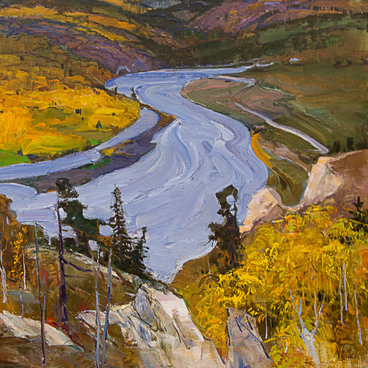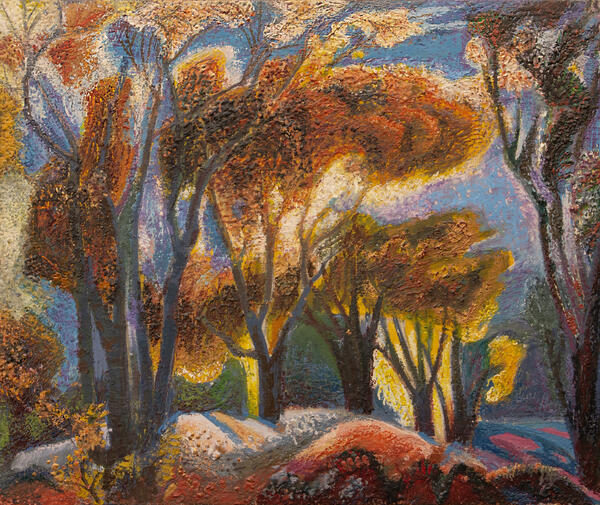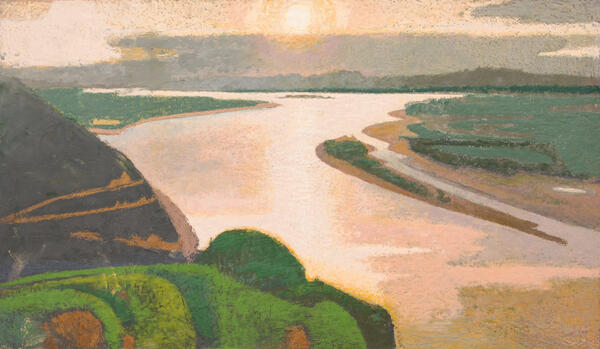Dmitry Andreyevich Gutov came to Komsomolsk-on-Amur at the age of seven: his family moved there from the village of Travnoye in the Novosibirsk region. Since childhood, the future artist watched his mother and sisters weave lace and admired the icons of his Old-Believer grandmother.
He graduated from school right when the Great Patriotic War started, and the yesterday’s graduate got a job as an artist at a carpet factory. In 1944, he entered a nautical school in Nikolayevsk-on-Amur, then he went to study in Kyiv. There, Gutov graduated from an art school (1946–1949) and the State Art Institute. He would always remember his professors with gratitude.
In 1954, Dmitry Gutov returned to the Russian Far East in search of material for his graduation project — a historical and ethnographic painting “For Debts”.
His natural propensity to compete helped him earn respect among the Nanai natives: the young artist challenged local hunters and unexpectedly won a shooting competition. Later, he thoroughly studied the local customs and created many bright, colorful images.
Judging by the bright expensive fabric of the robe and eye-catching jewelry, the sitter for the painting “Nanai Bride” comes from a wealthy family. The woman’s gaze is directed downward, not at the viewer and not even at the wedding bouquet in her hands; the artist managed to masterfully convey her detached and slightly sad state of mind and her reflection as to what life would be like in her new family.
The full cycle of matchmaking and marriage ceremonies of the Nanai people could last up to several years. Sometimes, future newlyweds became engaged in their infancy; also, a groom’s family could take a four-to-six-year-old girl and bring her up in the traditions of their family until the marriageable age of 16–17. A widowed man could marry the younger sister of his deceased wife. The age difference, even up to 25 years, and the fact which of the two was older did not matter.
Most often, the story of a marriage began with the choice of a bride for the grownup son and the “medeliku” rite when the bride’s parents were asked for their blessing. Agreeing right away was considered inappropriate, and the consultations between the families lasted for about a week, with the last word reserved for the bride’s mother. At the second meeting called “engsi”, the bride price was negotiated; the third meeting, “degbeliku”, implied presenting the bride’s dowry and discussing her move to the new home. Only after that came the wedding feast called “sarin” with various competitions, rites and sacrifices, believed to bring children, wealth and perseverance in overcoming difficulties.
He graduated from school right when the Great Patriotic War started, and the yesterday’s graduate got a job as an artist at a carpet factory. In 1944, he entered a nautical school in Nikolayevsk-on-Amur, then he went to study in Kyiv. There, Gutov graduated from an art school (1946–1949) and the State Art Institute. He would always remember his professors with gratitude.
In 1954, Dmitry Gutov returned to the Russian Far East in search of material for his graduation project — a historical and ethnographic painting “For Debts”.
His natural propensity to compete helped him earn respect among the Nanai natives: the young artist challenged local hunters and unexpectedly won a shooting competition. Later, he thoroughly studied the local customs and created many bright, colorful images.
Judging by the bright expensive fabric of the robe and eye-catching jewelry, the sitter for the painting “Nanai Bride” comes from a wealthy family. The woman’s gaze is directed downward, not at the viewer and not even at the wedding bouquet in her hands; the artist managed to masterfully convey her detached and slightly sad state of mind and her reflection as to what life would be like in her new family.
The full cycle of matchmaking and marriage ceremonies of the Nanai people could last up to several years. Sometimes, future newlyweds became engaged in their infancy; also, a groom’s family could take a four-to-six-year-old girl and bring her up in the traditions of their family until the marriageable age of 16–17. A widowed man could marry the younger sister of his deceased wife. The age difference, even up to 25 years, and the fact which of the two was older did not matter.
Most often, the story of a marriage began with the choice of a bride for the grownup son and the “medeliku” rite when the bride’s parents were asked for their blessing. Agreeing right away was considered inappropriate, and the consultations between the families lasted for about a week, with the last word reserved for the bride’s mother. At the second meeting called “engsi”, the bride price was negotiated; the third meeting, “degbeliku”, implied presenting the bride’s dowry and discussing her move to the new home. Only after that came the wedding feast called “sarin” with various competitions, rites and sacrifices, believed to bring children, wealth and perseverance in overcoming difficulties.




